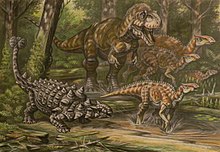
A bone bed is any geological stratum or deposit that contains bones of whatever kind. Inevitably, such deposits are sedimentary in nature. Not a formal term, it tends to be used more to describe especially dense collections such as Lagerstätte. It is also applied to brecciated and stalagmitic deposits on the floor of caves, which frequently contain osseous remains.

Philip John Currie is a Canadian palaeontologist and museum curator who helped found the Royal Tyrrell Museum of Palaeontology in Drumheller, Alberta and is now a professor at the University of Alberta in Edmonton. In the 1980s, he became the director of the Canada-China Dinosaur Project, the first cooperative palaeontological partnering between China and the West since the Central Asiatic Expeditions in the 1920s, and helped describe some of the first feathered dinosaurs. He is one of the primary editors of the influential Encyclopedia of Dinosaurs, and his areas of expertise include theropods, the origin of birds, and dinosaurian migration patterns and herding behavior. He was one of the models for palaeontologist Alan Grant in the film Jurassic Park.
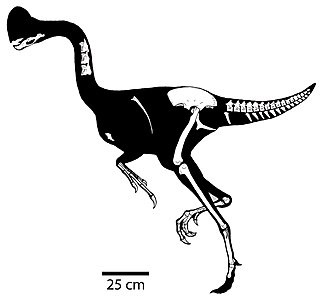
Chirostenotes is a genus of oviraptorosaurian dinosaur from the late Cretaceous of Alberta, Canada. The type species is Chirostenotes pergracilis.

Caenagnathus is a genus of caenagnathid oviraptorosaurian dinosaur from the late Cretaceous period. It is known from partial remains including lower jaws, a tail vertebra, hand bones, and hind limbs, all found in the Dinosaur Park Formation of Alberta, Canada. Caenagnathus measured about 2.5 m (8.2 ft) long and weighed about 96–100 kg (212–220 lb).
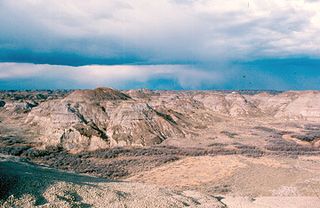
The Dinosaur Park Formation is the uppermost member of the Belly River Group, a major geologic unit in southern Alberta. It was deposited during the Campanian stage of the Late Cretaceous, between about 76.5 and 74.4 million years ago. It was deposited in alluvial and coastal plain environments, and it is bounded by the nonmarine Oldman Formation below it and the marine Bearpaw Formation above it.
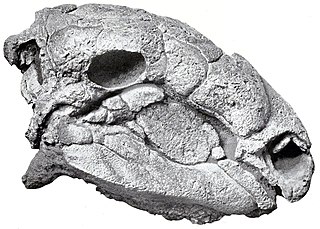
Panoplosaurus is a genus of armoured dinosaur from the Late Cretaceous of Alberta, Canada. Few specimens of the genus are known, all from the middle Campanian of the Dinosaur Park Formation, roughly 76 to 75 million years ago. It was first discovered in 1917, and named in 1919 by Lawrence Lambe, named for its extensive armour, meaning "well-armoured lizard". Panoplosaurus has at times been considered the proper name for material otherwise referred to as Edmontonia, complicating its phylogenetic and ecological interpretations, at one point being considered to have existed across Alberta, New Mexico and Texas, with specimens in institutions from Canada and the United States. The skull and skeleton of Panoplosaurus are similar to its relatives, but have a few significant differences, such as the lumpy form of the skull osteoderms, a completely fused shoulder blade, and regularly shaped plates on its neck and body lacking prominent spines. It was a quadrupedal animal, roughly 5 m (16 ft) long and 1,600 kg (3,500 lb) in weight. The skull has a short snout, with a very domed surface, and bony plates directly covering the cheek. The neck had circular groups of plates arranged around the top surface, both the forelimb and hindlimb were about the same length, and the hand may have only included three fingers. Almost the entire surface of the body was covered in plates, osteoderms and scutes of varying sizes, ranging from large elements along the skull and neck, to smaller, round bones underneath the chin and body, to small ossicles that filled in the spaces between other, larger osteoderms.

Prenoceratops, is a genus of herbivorous ceratopsian dinosaur from the Late Cretaceous Period. It was a relatively small dinosaur, reaching 1.3 m (4.3 ft) in length and 20 kg (44 lb) in body mass. Its fossils have been found in the upper Two Medicine Formation in the present-day U.S. state of Montana, in Campanian age rock layers that have been dated to 74.3 million years ago. Fossils were also found in the Oldman Formation in the modern day Canadian province of Alberta, dating to around 77 million years ago.
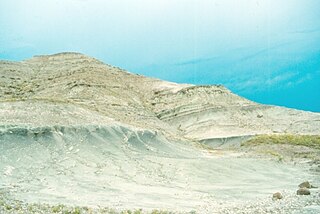
The Two Medicine Formation is a geological formation, or rock body, in northwestern Montana and southern Alberta that was deposited between 83.5 ± 0.7 Ma and 70.6 ± 3.4 Ma, during Campanian time. It crops out to the east of the Rocky Mountain Overthrust Belt, and the western portion of this formation is folded and faulted while the eastern part, which thins out into the Sweetgrass Arch, is mostly undeformed plains. Below the formation are the nearshore deposits of the Virgelle Sandstone, and above it is the marine Bearpaw Shale. Throughout the Campanian, the Two Medicine Formation was deposited between the western shoreline of the Late Cretaceous Interior Seaway and the eastward advancing margin of the Cordilleran Overthrust Belt. The Two Medicine Formation is mostly sandstone, deposited by rivers and deltas.

The Judith River Formation is a fossil-bearing geologic formation in Montana, and is part of the Judith River Group. It dates to the Late Cretaceous, between 79 and 75.3 million years ago, corresponding to the "Judithian" land vertebrate age. It was laid down during the same time period as portions of the Two Medicine Formation of Montana and the Oldman Formation of Alberta. It is an historically important formation, explored by early American paleontologists such as Edward Drinker Cope, who named several dinosaurs from scrappy remains found here on his 1876 expedition. Modern work has found nearly complete skeletons of the hadrosaurid Brachylophosaurus.
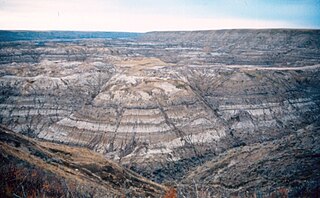
The Horseshoe Canyon Formation is a stratigraphic unit of the Western Canada Sedimentary Basin in southwestern Alberta. It takes its name from Horseshoe Canyon, an area of badlands near Drumheller.

The Nemegt Formation is a geological formation in the Gobi Desert of Mongolia, dating to the Late Cretaceous. The formation consists of river channel sediments and contains fossils of fish, turtles, crocodilians, and a diverse fauna of dinosaurs, including birds.
The Milk River Formation is a sandstone-dominated stratigraphic unit of the Western Canada Sedimentary Basin in southern Alberta, Canada. It was deposited in near-shore to coastal environments during Late Cretaceous time. Based on uranium-lead dating, palynology and stratigraphic relationships, deposition occurred between ~84.1 and 83.6 Ma.
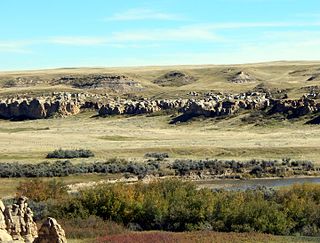
The Foremost Formation is a stratigraphic unit of Late Cretaceous (Campanian) age that underlies much of southern Alberta, Canada. It was named for outcrops in Chin Coulee near the town of Foremost and is known primarily for its dinosaur remains and other fossils.
The Wapiti Formation is a geological formation of the Western Canada Sedimentary Basin in northwestern Alberta, and northeastern British Columbia, Canada. Its deposition spanned the time interval from the lower Campanian through to the upper Maastrichtian, between approximately 80 and 68 Ma. It was named by G.M. Dawson in 1881, presumably for exposures along the lower part of the Wapiti River and downstream along the Smoky River in Alberta.

The Cerro del Pueblo Formation is a geological formation in Coahuila, Mexico whose strata date back to the Late Cretaceous. Dinosaur remains are among the fossils that have been recovered from the formation. The formation is believed to correlate with the Baculites reesidesi and Baculites jenseni ammonite zones, which dates it to 73.63-72.74 Ma.

Albertadromeus is an extinct genus of orodromine thescelosaurid dinosaur known from the upper part of the Late Cretaceous Oldman Formation of Alberta, Canada. It contains a single species, Albertadromeus syntarsus.

Orodrominae is a subfamily of thescelosaurid dinosaurs known from the Cretaceous of North America and Asia.


